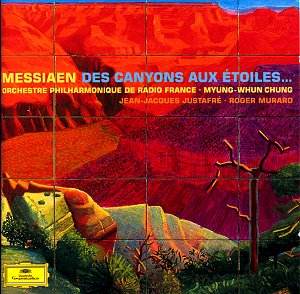Messiaen’s Des canyons aux étoiles ...
was written as a commission to celebrate the bicentennial of the United
States. It was composed between 1971 and 1974. The US premiere took
place in November 1974 whereas the European first performance followed
in October 1975. The latter was conducted by Marius Constant who made
the first recording for Erato some time later, if my memory serves me
well.
As might be expected, Messiaen approached this commission
in his own idiosyncratic and inimitable way. This large-scale triptych
has nothing to do with any sort of Americana, but is again – first and
foremost – a religious meditation inspired by the grand landscapes of
the Utah canyons. Messiaen drew on many inspirational sources: religious
texts by the philosopher Ernest Hello, Psalms, astronomy and ... birds.
The sun-drenched, parched landscapes of Utah also suggested the orchestral
layout of the piece: piano, horn, a sizeable wind ensemble, 13 strings
and a huge percussion section including a wind machine, a thunder plate
and a "geophone" (an instrument devised by Messiaen, in fact
a large flat drum filled with lead shot and slowly rotated to make a
sound like sifting sand) and almost soloistic parts for xylorimba and
glockenspiel. Messiaen also calls for some unusual instrumental playing
techniques to achieve some indeterminate sounds, such as trumpet players
blowing through the mouth piece or the horn player (in Appel interstellaire)
being instructed to play some phrases by halfway raising or depressing
the keys.
As is often the case with Messiaen, the music is extraordinarily
sophisticated and sometimes remarkably naive. Landscapes or physical
sensations are suggested in directly descriptive clichés such
as massive block chords and by a whole array of percussive sounds as
well as some instrumental techniques already mentioned. Messiaen again
exploits the whole of his compositional palette and technique, building
movements on complex rhythmic schemes, inserting long cadenzas of bird
songs and conjuring-up his unmistakable sound world often achieved by
accumulation and juxtaposition rather than development in the traditional
symphonic manner. Another remarkable feature of the piece is the use
of numerology. There are twelve movements (the apostles and, as suggested
by Michael Stegemann, the numerus sonorus representing the Heavenly
Jerusalem) arranged in three parts of five, two and five movements respectively.
Each part ends with a movement depicting one of the great Utah sights
(Cedar Breaks, Bryce Canyon and Zion Park), whereas the first and third
part each includes a big piano cadenza on bird songs. (The number 5
is also noteworthy as it is, according to Stegemann, King David’s Holy
Number. The first and third parts have five movements each, movements
3 and 5 are in five symmetrically structured sections, five movements
include bird songs and five movements are headed with Biblical texts.)
Comments like these are, I am afraid, likely to highlight Messiaen’s
fastidious working methods at the expense of the music which, for all
its complexity and sophistication, is remarkably direct, quite impressive
and often deeply moving as in the beautifully ecstatic movement Les
ressuscits et l'toile Aldbaran opening the third part. To a certain
extent, Des canyons aux étoiles... is the summation
of Messiaen’s musical progress, which later works such as the magnificent
Eclairs sur l’au-delà... and Concert à
quatre will but consolidate.
The present performance is superb. Myung-Whun Chung
has long demonstrated his empathy with Messiaen’s music whereas Roger
Muraro is now highly regarded as one of the finest Messiaen interpreters.
The recording is simply magnificent and the production up to DG’s best
with excellent notes by Paul Griffiths (in English), Harry Halbreich
(in French) and Michael Stegemann (in German). The only drawback is
the playing time that is a bit on the short side, a pity especially
at DG’s full price. (Incidentally, Salonen’s excellent reading on Sony
also includes two substantial "fill-ups", i.e. Oiseaux
exotiques and Couleurs de la cité céleste.)
This is nevertheless a quite remarkable achievement that may be wholeheartedly
recommended.
Hubert Culot

![]() Roger Muraro (piano);
Jean-Jacques Justafé (horn); Francis Petit (xylorimba); Renaud
Muzzolini (Glockenspiel)
Roger Muraro (piano);
Jean-Jacques Justafé (horn); Francis Petit (xylorimba); Renaud
Muzzolini (Glockenspiel) ![]() DEUTSCHE GRAMMOPHON
471 617-2 [47:52 + 44:15]
DEUTSCHE GRAMMOPHON
471 617-2 [47:52 + 44:15]